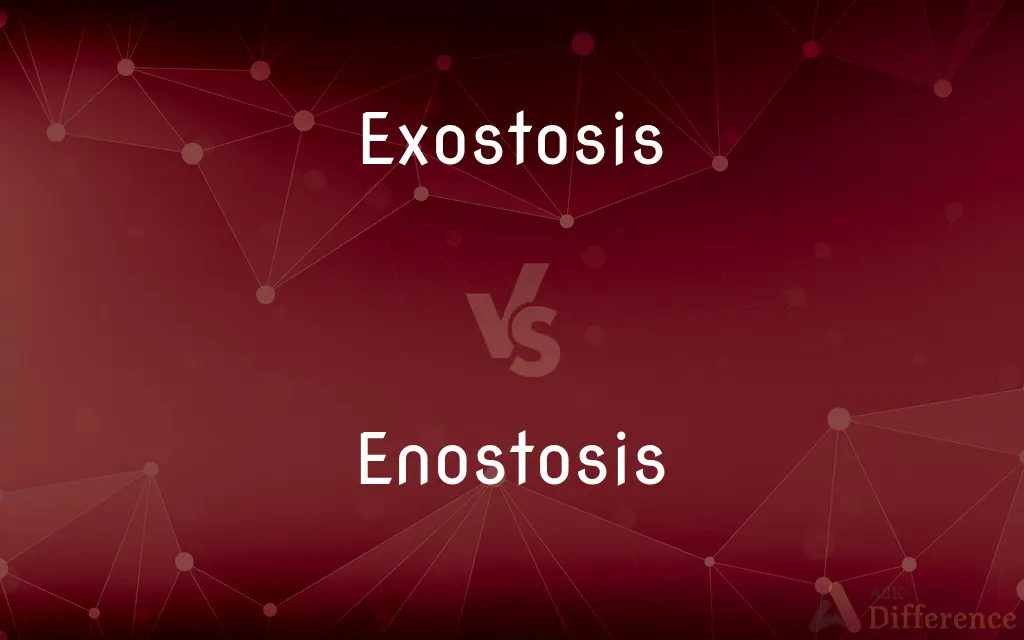Exostosis vs. Enostosis — What's the Difference?
By Fiza Rafique & Urooj Arif — Updated on March 29, 2024
Exostosis involves bone growth on the surface of a bone, often causing discomfort or pain, whereas enostosis represents an internal growth within a bone, typically asymptomatic.

Difference Between Exostosis and Enostosis
Table of Contents
ADVERTISEMENT
Key Differences
Exostosis is characterized by the formation of new bone on the surface of an existing bone, often resulting from irritation or inflammation. This can lead to visible bumps or lumps on the bone's surface. On the other hand, enostosis, also known as a bone island, is a focal area of increased bone density found within the cancellous or spongy part of the bone and is usually discovered incidentally on radiographs.
While exostosis can occur in any bone, it is most commonly found in areas where bones are subject to repeated stress or trauma, such as the knees, shoulders, and feet. Enostosis, however, does not have a predilection for specific locations and can occur in any bone, including the long bones, pelvis, and vertebrae.
Exostosis may sometimes lead to discomfort or restrict joint movement, depending on its size and location. Patients with exostosis often seek medical attention due to pain or functional limitations. Conversely, enostosis is generally asymptomatic and does not usually affect the bone's function or cause pain, often being an incidental finding during imaging for unrelated reasons.
Treatment for exostosis often involves surgical removal if the growth causes significant discomfort, restricts movement, or leads to other complications. Enostosis, in contrast, typically requires no treatment. It is monitored over time to ensure that it does not signify a more serious underlying condition.
The cause of exostosis is often linked to chronic irritation or trauma, suggesting a reactive process. Enostosis, meanwhile, is considered a developmental anomaly, with its exact cause remaining largely unknown but not typically associated with external factors.
ADVERTISEMENT
Comparison Chart
Definition
Bone growth on the surface of a bone
Internal bone growth within a bone
Common Locations
Knees, shoulders, feet
Any bone, including long bones and pelvis
Symptoms
Can cause discomfort, pain, or restrict movement
Usually asymptomatic
Treatment
Surgical removal if symptomatic
Monitoring, usually no treatment required
Associated Factors
Often linked to irritation, inflammation, or trauma
Considered a developmental anomaly
Compare with Definitions
Exostosis
Can sometimes lead to other conditions if it interferes with tendons or ligaments.
The runner had surgery to remove an exostosis that was irritating a tendon.
Enostosis
Also known as a bone island, typically found during imaging for unrelated reasons.
A routine chest x-ray revealed an enostosis in the rib.
Exostosis
Often associated with repeated trauma or stress to a bone.
Professional dancers sometimes develop exostosis in their feet due to constant pressure.
Enostosis
Generally asymptomatic and does not require treatment.
The discovered enostosis in his spine required no intervention.
Exostosis
A benign outgrowth of cartilaginous tissue on a bone.
The x-ray revealed an exostosis on the patient's shoulder blade.
Enostosis
Does not usually affect bone function or cause discomfort.
Despite the enostosis in his tibia, the athlete experienced no pain or limitation.
Exostosis
Abnormal bone growth on the surface of a bone.
The skateboarder developed an exostosis on his knee after years of falls and injuries.
Enostosis
A dense, benign growth within the spongy interior of a bone.
The MRI incidentally found an enostosis in the patient's femur.
Exostosis
May require surgical removal if symptomatic.
The painful exostosis on her heel was surgically removed.
Enostosis
Considered a variant of normal bone architecture.
The enostosis in her pelvis was deemed a normal anatomical variation.
Exostosis
An exostosis, also known as bone spur, is the formation of new bone on the surface of a bone. Exostoses can cause chronic pain ranging from mild to debilitatingly severe, depending on the shape, size, and location of the lesion.
Enostosis
An enostosis is a small area of compact bone within the cancellous bone. They are commonly seen as an incidental finding on radiographs or CT scans.
Exostosis
A bony growth on the surface of a bone or tooth.
Enostosis
A small area of compact bone within the cancellous bone.
Exostosis
A benign bony growth, often covered with cartilage, on the surface of a bone or tooth.
Exostosis
Any protuberance of a bone which is not natural; an excrescence or morbid enlargement of a bone.
Exostosis
A knot formed upon or in the wood of trees by disease.
Exostosis
A benign outgrowth from a bone (usually covered with cartilage)
Common Curiosities
What is exostosis?
Exostosis is a condition where new bone growth occurs on the surface of an existing bone, often due to irritation or trauma.
Can exostosis be painful?
Yes, exostosis can cause discomfort or pain, especially if it interferes with muscle or joint function.
Is enostosis a cause for concern?
Enostosis is generally not a concern as it is usually asymptomatic and does not require treatment.
How are exostosis and enostosis diagnosed?
Both conditions are often diagnosed using imaging techniques such as X-rays, CT scans, or MRIs.
Does enostosis grow?
Enostosis is usually stable and does not grow significantly over time.
What is enostosis?
Enostosis, or a bone island, refers to a benign, dense growth within the interior of a bone, usually discovered incidentally.
Can exostosis lead to cancer?
While exostosis itself is benign, very rarely, some types can evolve into malignant growths.
Who is at risk for developing exostosis?
Individuals exposed to repeated stress or trauma to bones, such as athletes or manual laborers, are at higher risk.
How common is enostosis?
Enostosis is relatively common and often discovered during imaging for other reasons.
What causes exostosis?
Exostosis is often caused by chronic irritation, inflammation, or trauma to a bone.
Is surgery always required for exostosis?
Surgery is only required if exostosis causes significant discomfort, pain, or movement restriction.
What causes enostosis?
The exact cause of enostosis is unknown, but it is considered a developmental anomaly.
Can children develop enostosis?
Yes, enostosis can occur in children and is usually detected incidentally.
How is enostosis treated?
Enostosis does not usually require treatment but may be monitored to ensure it does not indicate a more serious condition.
Can exostosis affect any bone?
Yes, exostosis can affect any bone but is most commonly found in bones subjected to repeated stress or trauma.
Share Your Discovery

Previous Comparison
Disingenuous vs. Duplicitous
Next Comparison
Ambiguity vs. NebulousAuthor Spotlight
Written by
Fiza RafiqueFiza Rafique is a skilled content writer at AskDifference.com, where she meticulously refines and enhances written pieces. Drawing from her vast editorial expertise, Fiza ensures clarity, accuracy, and precision in every article. Passionate about language, she continually seeks to elevate the quality of content for readers worldwide.
Co-written by
Urooj ArifUrooj is a skilled content writer at Ask Difference, known for her exceptional ability to simplify complex topics into engaging and informative content. With a passion for research and a flair for clear, concise writing, she consistently delivers articles that resonate with our diverse audience.














































